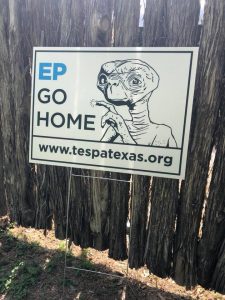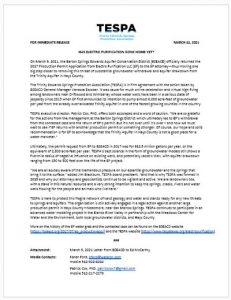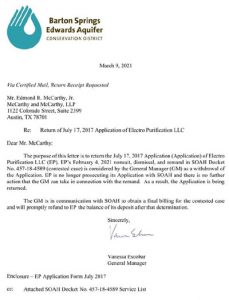 “We couldn’t be happier to hear that the BSEACD is returning EP’s application fee and cancelling the permitting process. Who knows what EP’s next move will be, but today is a big win for well owners, residents, and visitors who love the Hill Country. Most of all, it’s a reprieve for the precious groundwater that sustains us all and our natural ecosystem. The outrageous volume requested by EP would have hurt the entire region.” – David Baker, WVWA Executive Director
“We couldn’t be happier to hear that the BSEACD is returning EP’s application fee and cancelling the permitting process. Who knows what EP’s next move will be, but today is a big win for well owners, residents, and visitors who love the Hill Country. Most of all, it’s a reprieve for the precious groundwater that sustains us all and our natural ecosystem. The outrageous volume requested by EP would have hurt the entire region.” – David Baker, WVWA Executive Director
The WVWA is proud to partner with TESPA to protect land and water resources in the Hill Country through the Hill Country Legal Defense Fund.
TESPA issued a press release on Thursday, March 11 explaining the BSEACD permit actions and the implications for EP:
On March 9, 2021, the Barton Springs Edwards Aquifer Conservation District (BSEACD) officially returned the 2017 Production Permit Application from Electro Purification LLC (EP) to the EP attorney—thus moving one big step closer to removing this threat of substantial groundwater withdrawal and aquifer drawdown from the Trinity Aquifer in Hays County.
The Trinity Edwards Springs Protection Association (TESPA) is in firm agreement with the action taken by BSEACD General Manager Vanessa Escobar. It was cause for much online celebration and virtual high fiving among landowners near Driftwood and Wimberley whose water wells have been in a serious state of jeopardy since 2015 when EP first announced its intention to pump almost 6,000 acre-feet of groundwater per year from the already over-allocated Trinity Aquifer in one of the fastest growing counties in the country.
TESPA executive director, Patrick Cox, PhD, offers both accolades and a word of caution, “We are so grateful for the actions from the management at the Barton Springs District which ultimately led to EP’s withdrawal from the contested case and the return of EP’s permit. But it’s not over until it’s over – and now we must wait to see if EP returns with another production permit or something stronger. Of course, our hope and solid recommendation is for EP to acknowledge that the Trinity Aquifer in Hays County is not a good place for a
water marketer.”Ultimately, the permit request from EP to BSEACD in 2017 was for 912.5 million gallons per year, or the equivalent of 2,800 acre-feet per year. TESPA’s best science in the form of groundwater models still shows a five-mile radius of negative influence on existing wells, and potentially Jacob’s Well, with aquifer drawdown ranging from 150 to 500 feet over the life of the EP project.
“We are all acutely aware of the tremendous pressure on our essential groundwater and the springs that bring it to the surface,” added Jim Blackburn, TESPA board president, “and that is why TESPA was formed in 2015 and why our attorneys and geoscientists continue to be vigilant and active. We are landowners too, with a stake in this natural resource and a very strong intention to keep the springs, creeks, rivers and water wells flowing for the people and animals who live here.”
TESPA is here to protect this fragile network of karst geology and water and stands ready for any new threats to springs and aquifers. The organization is still actively engaged in a legal action against another large production permit in Hays County—Needmore, near San Marcos Springs. TESPA continues to participate in an advanced water modeling project in the Blanco River Valley in partnership with the Meadows Center for Water and the Environment, both local groundwater districts, and Hays County.
More on the history of the EP water grab and the contested case can be found on the BSEACD website (https://bseacd.org/2017/07/ep_productionapp/) and the TESPA website (https://www.tespatexas.org/electropurification).


